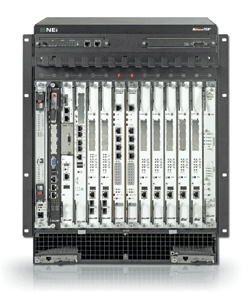Growing enclosure specs for continued success
Flexible AdvancedTCA moves facilely into new environments
By RICHARD COMERFORD
Editor, Electronic Products
It is practically impossible to enter a telecom facility today without seeing racks of equipment housed in enclosures that conform to Advanced Telecom Computing Architecture (AdvancedTCA) specifications. Many of the racks have been in place now for well over five years, during which time they have been easily adapted to the telecom carriers’ rapidly changing needs.

The A-13000 ATCA chassis from NEI (www.nei.com) uses best-of-breed components to optimize price/performance for next-generation carrier applications.
AdvancedTCA was the creation of the PCI Industrial Computer Manufacturers Group. Founded in 1994, PICMG is a consortium of more than 400 companies that collaboratively develop open specifications for high-performance telecommunications, military, and industrial computing enclosures and applications. The group is responsible for such specifications as CompactPCI and CompactPCI Express and others.
The PICMG consortium began defining AdvancedTCA specifications early in the last decade. The original goal of the AdvancedTCA family of specifications was to create a foundation for a set of common platforms, with a large selection of interchangeable modules from many companies, for use in telecommunications applications.
Specification architecture
The architecture is defined in a series of PICMG 3.x specifications, targeted to requirements for next-generation, carrier-grade communications equipment. This series was designed to incorporate the latest trends in high-speed interconnect technologies, next-generation processors, and improved reliability, manageability, and serviceability.
PICMG 3.0 R1.0, which is the core AdvancedTCA specification, defines the board, backplane, and shelf mechanicals, power distribution, and the connectivity required for system management. Multiple zones for connectors and their alignment and keying features are also defined, and the physical mapping to a connector family is specified.
The specific fabric definitions are defined in subsidiary specifications. For example, PICMG 3.1 R1.0, defines how Ethernet and Fibre Channel are mapped onto PICMG 3.0, with the intended implementation practice to normally include at least one link of Ethernet; usage of Fibre Channel is optional.
Thus component interoperability is defined by the combined PICMG 3.0 core specification and a subsidiary fabric specification. Other subsidiary specifications currently include those for InfiniBand (PICMG 3.2), StarFabric (3.3), PCI Express/advanced Switching (3.4), RapidIO (3.5), and Packet Routing Switch (3.6).
The development of the AdvancedTCA specification was the largest project ever undertaken by PICMG. The original AdvancedTCA specification, released in January 2003, satisfied requirements for a bladed computing architecture capable of switching and processing 2.5 Tbits/s in a single shelf.
Beyond the telecom carrier
Since its introduction, the architecture has proven successful in telecom central office environments, and is said to be the only truly open bladed architecture available today. But in addition to fulfilling its original aim of satisfying telecom needs, AdvancedTCA has penetrated additional markets, including military, factory, financial, and research markets.
Last year, PICMG announced plans to expand the AdvancedTCA platform capabilities so as to address additional markets, such as network data centers and cloud computing environments, beyond its telecom base. PICMG President Joe Pavlat noted that “we will be adding significantly increased power and compute density to the AdvancedTCA platform and building on its success.”
This new effort addresses additional features, including double-wide boards, enhancements to power and cooling, optimizations for non-NEBS environments, allowances for double-sided shelves, and other enhancements. At the same time, it will maintain forward and backward compatibility with existing AdvancedTCA products.
This work of advancing the specification is being performed by a new subcommittee open to all PICMG Executive and Associate members. ■
For a look at some of the most recent chassis products, visit http://electronicproducts-com-develop.go-vip.net/c-article-rurc_cande_dec2009-html.aspx
Advertisement
Learn more about Electronic Products Magazine





